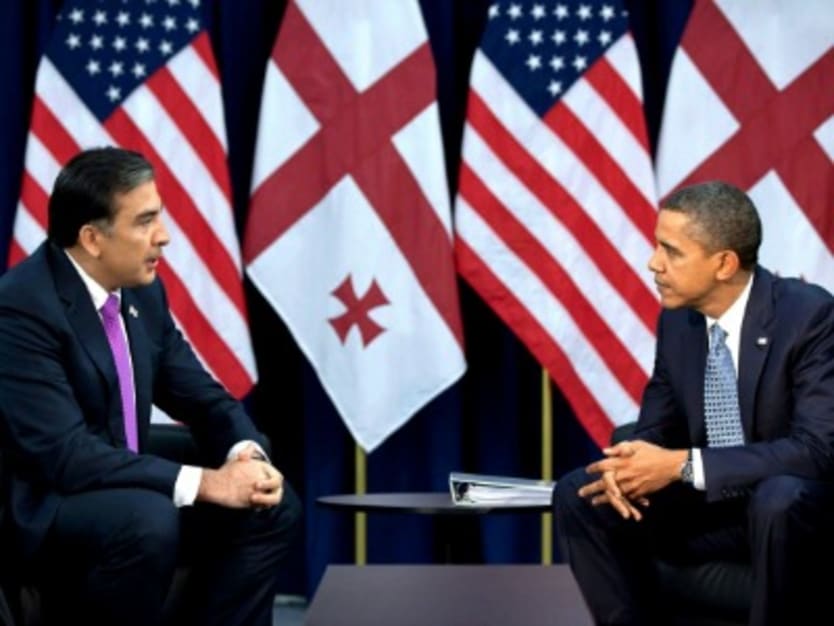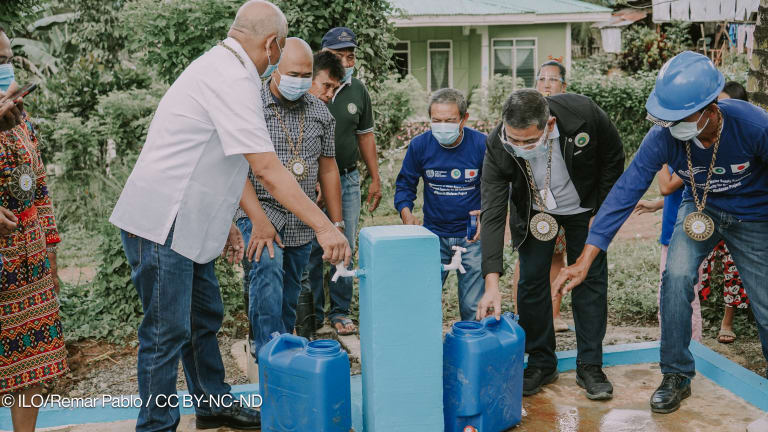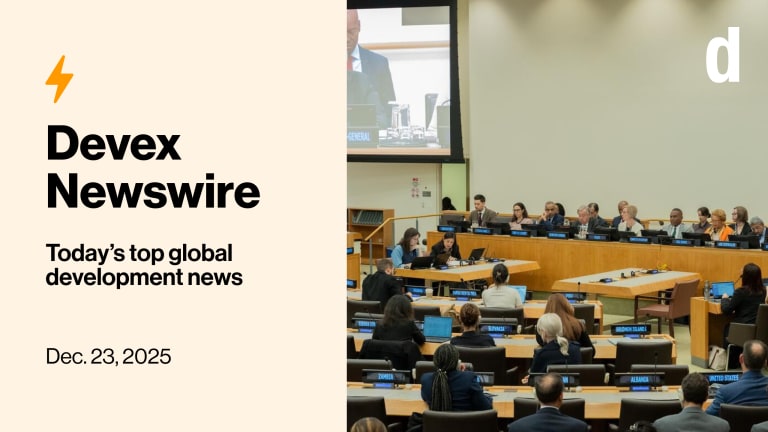
The former Soviet Republic of Georgia has been one of the highest per-capita recipients of United States foreign aid for nearly two decades. Roughly the size and population of Ireland, Georgia received $1.8 billion in foreign assistance from the Clinton and Bush administrations between 1993 and 2007.
In August 2008, in the aftermath of Georgia’s five-day war with Russia over the breakaway regions of Abkhazia and South Ossetia, the United States ramped up its aid engagement with its Caucasus region ally further. Even as Washington was figuring out how to deal with the ongoing global financial meltdown, the Bush administration won broad bipartisan backing for $1 billion in emergency post-war assistance to Georgia.
“Even where I come from, a billion dollars for 5 million people is a lot of money,” U.S. Vice President Joe Biden said of the $1 billion U.S. assistance package for Georgia during a visit to the capital Tbilisi in 2009.
From his perch as the then-chairman of the Senate Foreign Relations Committee, Biden had been the first to propose a $1 billion increase in U.S. assistance to Georgia following the short-lived but catastrophic war which claimed the lives of 850 people and displaced over 100,000. The conflict also dealt a severe blow to the Georgian economy: in 2008, Georgian GDP grew by just 2 percent compared to 12 percent in 2007.
In the years since, however, post-war assistance from the U.S. and other donors has helped Georgia’s economy re-emerge as one of the fastest-growing in the former Soviet bloc. Soon after the conflict, 38 donor governments and 15 multilateral lenders announced a total of $4.5 billion in aid to Georgia, exceeding the $3.25 billion in international financing which the World Bank estimated was needed to buttress the country’s recovery. Released in tranches between 2008 and 2010, the $1 billion in American assistance represented the largest contribution by a single donor.
An important part of the Bush administration aid package was a cash transfer of $250 million to the Georgian government to help cover state expenditures. Historically, the U.S. has only provided this level of budget support to leading strategic partners such as Egypt and Jordan.
Amid budget pressures, USAID likely to reduce footprint
Since 2011, U.S. President Barack Obama has allocated roughly $80 million in annual foreign assistance to Georgia, well below the previous three years but still comparable to pre-war levels. Experts on U.S.-Georgia relations say that this indicates that Georgia has remained a priority of the U.S. foreign policy and development agenda under Obama.
“I wouldn’t say that the Obama administration has deemphasized Georgia in any particular way. Georgia continues to be an important strategic partner of the United States, which also continues to take considerable interest in the country’s democratic development and its relations with Russia,” asserts Cory Welt, associate director of the George Washington University’s Institute for European, Russian, and Eurasian Studies.
Just recently, during a meeting with Georgian President Mikheil Saakashvili in Arizona, Biden reaffirmed continued American support for Georgia. Last year, a bipartisan working group organized by the Center for Global Development and Center for American Progress named Georgia one of 32 priority investment countries for which continued or increased U.S. foreign aid was justified even in a budget-constrained environment.
Acknowledging Georgia’s rapid post-conflict recovery and socio-economic development, some U.S. aid officials express doubt that the country will sustain the aid levels it has enjoyed over the last several years. In a recent interview with Devex, the U.S. Agency for International Development’s Mission Director in Georgia Stephen Haykin asserts that budget pressures in Washington could very well result in further cuts to the USAID budget for the country.
“USAID funding to Georgia will be comparable to pre-crisis levels, albeit with modest annual reductions likely,” Haykin told Devex.
Haykin added that while USAID Georgia will continue programming in its focus areas of democracy and governance, economic growth, and social inclusion, it will gradually wind down its support in a number of other sectors over the next five years.
“As we complete and finish work funded from the $1 billion pledge, we expect to phase out of large-scale infrastructure. Further, by 2017, we expect to complete assistance in health and basic education,” said Haykin.
In 2012, democracy and governance and economic development each garnered 30 percent of the United States’ $85 million aid budget for Georgia. Meanwhile, health and education accounted for only seven percent and two percent, respectively.
Second MCC compact in the pipeline
While USAID plans to reduce its footprint in Georgia, another major U.S. aid agency – the Millennium Challenge Corp. – is poised to resume engagement with the country.
Amid tight competition for MCC funding, on April 9 the MCC notified Congress of its intent to begin negotiations with the Georgian government for a second compact valued at $140 million. According to the performance-based U.S. aid agency, the MCC board could sign off on a second Georgia compact later this year which would last up to five years. The compact is expected to focus entirely on general education, technical and vocational education and training, and higher education.
In 2011, Georgia successfully completed a five-year, $395 million MCC compact which supported infrastructure, transport and agriculture programming. The Bush administration’s $1 billion post-war assistance package for Georgia had provided an additional $100 million to the original $295 million MCC compact. Georgia was one of the first countries to sign an MCC compact back in 2005.
USAID Georgia anticipates that MCC’s reengagement with the country would likely facilitate its planned exit from the basic education sector.
“If a second MCC Compact is ratified in FY 2013, we can expect MCC educational investments to come online by FY 2015, helping sustain USAID’s investments in the sector and easing USAID’s phase out of basic education programming,” reads USAID Georgia’s 2013-2017 country development cooperation strategy.
Georgia political transition to have little impact on U.S. aid engagement
Known as a staunch ally of then-U.S. President George W. Bush, Georgian President Saakashvili is expected to step down from office after elections in October. Thrust into power after a popular uprising in 2003, Saakashvili relinquished much of his authority to Prime Minister Bidzina Ivanishvili when his United National Movement party lost parliamentary elections last year.
Despite concerns among some quarters that Ivanishvili and his Georgian Dream coalition could turn away from the West in favor of closer ties with Moscow, the new government in Tbilisi has made clear that it remains committed to robust development engagement with the Obama administration.
“Georgian Dream is anxious to continue working with the United States. There’s no question that at the leadership level… they believe the U.S. is absolutely a key and essential ally and that what the U.S. can offer is very valuable in terms of support and assistance,” said Lincoln Mitchell, an associate research scholar at Columbia University’s Harriman Institute who was an informal adviser to Ivanishvili during the 2012 Georgian parliamentary elections.
Haykin told Devex that he also anticipates that the ongoing political transition will have little impact on USAID’s programming in Georgia.
“USAID is fortunate that much of our assistance efforts are technical in nature and we have been able to maintain effective and collaborative relationships with counterparts from the previous and now with the new government. We see this positive and productive relationship continuing,” said Haykin.
Join the Devex community and access more in-depth analysis, breaking news and business advice – and a host of other services – on international development, humanitarian aid and global health.








